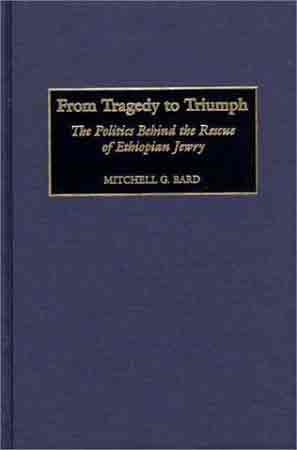From
Tragedy to Triumph:
The Politics behind the Rescue of Ethiopian
Jewry
 In
1984, 1985 and 1991, Israel dramatically
rescued thousands of Ethiopian Jews
in large-scale, secret airlifts. Thousands
more were brought to Israel in other
ways including government-run covert
operations, exchanges for arms and
open immigration. These operations
represent the triumph in the story
of the politics behind the rescue of
Ethiopian Jews, and illustrate what
Israel can do when Jewish lives are
at stake. While other countries turned
a blind eye to the suffering of the
thousands of refugees in the Sudan,
Israel took action. Mossad agents,
and Ethiopian Jews from Israel working
for them, risked their lives to save
other Jews in the tradition of pikuach
nefesh. As the Talmud says, to save
one life is as if one saved the entire
human race. The exploits of the agents
involved in the rescue were truly heroic. In
1984, 1985 and 1991, Israel dramatically
rescued thousands of Ethiopian Jews
in large-scale, secret airlifts. Thousands
more were brought to Israel in other
ways including government-run covert
operations, exchanges for arms and
open immigration. These operations
represent the triumph in the story
of the politics behind the rescue of
Ethiopian Jews, and illustrate what
Israel can do when Jewish lives are
at stake. While other countries turned
a blind eye to the suffering of the
thousands of refugees in the Sudan,
Israel took action. Mossad agents,
and Ethiopian Jews from Israel working
for them, risked their lives to save
other Jews in the tradition of pikuach
nefesh. As the Talmud says, to save
one life is as if one saved the entire
human race. The exploits of the agents
involved in the rescue were truly heroic.
The
United States government also played
an important role, especially in Operation
Sheba after public disclosures undermined
the Israeli operations. It was a rare
instance where an American administration
placed humanitarian concerns above
national interests.
Israel’s
effort to bring an ancient Jewish community
to its homeland also reinvigorated
the raison d' etre of Zionism that
Golda Meir had expressed when she said "there
is no Zionism except the rescue of
Jews." Jews in Israel and around
the world expected the response. As
Yehuda Dominitz related, "if someone
told Ugandan refugees a plane was going
to pick them up, they wouldn't believe
it....The Ethiopian Jews did believe
it...." The Ethiopian Jews, and
Jews around the world, knew that Israel
would answer the call made by Rabbi
Kook.
What
then is the tragedy referred to in
the title of this book?
The
tragedy of the story is that the chief
rabbi who warned of the extinction
of the Ethiopian Jews made his appeal
in 1921. It took nearly half a century
for world Jewry and the leaders of
Israel to take action to save this
ancient branch of the Jewish people.
The number of Ethiopian Jews, estimated
to be as high as 200,000 late in the
19th century had dwindled to 28,000
by the time of the 1976 census.
A handful
of activists, primarily in the United
States, helped prod the Israeli government
to act by demonstrating that mere “amateurs”
could rescue Jews, by constant lobbying
of both the Israeli and U.S. governments,
and by sometimes shameless propaganda
and unwarranted attacks on Israel’s
motives. While these advocates tirelessly
advanced the cause, the American Jewish
establishment stayed mostly silent,
satisfied with Israeli assurances that
everything that could be done was being
done.
The
tragedy is that the Beta Israel, a
proud people, who had maintained their
religion for millennia, had its Jewishness
questioned for years and nearly disappeared
before the eyes of a generation that
had watched helplessly as the Holocaust
unfolded. Did we fail to learn our
lesson from that event? If not, why
did it take so long to act on behalf
of the Ethiopian Jews and what were
the factors that brought about the
ultimate decision to prevent the community
from being relegated to an encyclopedia
entry, or a museum exhibit of lost
Jewish communities? The remainder of
this book will explore the answers
to these questions and explain the
politics behind the rescue of the Jews
of Ethiopia — the triumph and the tragedy.
CLICK
ON THE LINK BELOW TO ORDER
From
Tragedy to Triumph: The Politics
behind the Rescue of Ethiopian
Jewry
|